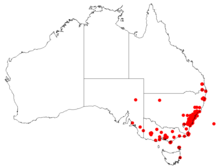
Hakea nodosa, commonly known as yellow hakea, is a shrub that is endemic to Australia. It usually has golden yellow flowers in profusion and needle-shaped leaves.

Hakea cygna, commonly known as the swan hakea, is usually a dense shrub endemic to Western Australia with creamy-white upright flowers appearing from July to August.

Hakea decurrens, commonly known as bushy needlewood, is a species of shrub or small tree in the family Proteaceae.

Hakea gibbosa, commonly known as hairy hakea or needlebush hakea, is a shrub of the family Proteaceae, and is endemic to south eastern Australia. It has very prickly foliage, cream-yellowish flowers from April to July, and provides shelter for small birds. It has become an environmental weed in South Africa and New Zealand, where it had been introduced for use as a hedge plant.

Hakea rugosa, commonly known as wrinkled hakea or dwarf hakea, is a shrub of the family Proteaceae native to Australia. It has sharp needle-shaped leaves and white or cream fragrant flowers in profusion from August to October.

Hakea dactyloides, commonly known as the finger hakea, is a widely distributed species mainly found in southeastern New South Wales, Australia. An attractive shrub or small tree for the home garden bearing sprays of cream-white flowers.

Hakea lorea, commonly known as bootlace oak or cork tree, is a species of shrub or small tree in the family Proteaceae found in central and northern Australia. It has needle-shape leaves, yellow, white or green flowers and hard corky bark.

Hakea tephrosperma commonly known as hooked needlewood, is a shrub or small tree species in the family Proteaceae. It has cream flowers, needle-shaped leaves and is one of the taller species adaptable for dry to temperate locations.

Hakea dohertyi, commonly known as the Kowmung hakea, is a shrub endemic to a restricted locale in the Great Dividing Range in central New South Wales in Australia.

Hakea eriantha, commonly known as tree hakea, is a shrub or small tree endemic to the east coast of Australia. It has white flowers on a woolly stem in leaf axils, long narrow leaves with reddish new growth. Found growing at higher altitudes in moist or sclerophyll Eucalyptus woodland.

Hakea circumalata is a shrub in the family Proteaceae native to an area in the Wheatbelt and Mid West regions of Western Australia. A small shrub producing a profusion of strongly scented pink to red flowers in dense clusters from July to September.

Hakea actites, commonly known as the mulloway needle bush or wallum hakea is a shrub or tree of the Proteacea family native to areas in north eastern New South Wales and south eastern Queensland. White nectar rich flowers appear in abundance from late autumn to early spring.

Hakea varia, commonly known as the variable-leaved hakea, is a shrub of the family Proteacea and endemic to Wheatbelt, South West, Great Southern and Goldfields-Esperance regions of Western Australia. It is a dense prickly shrub with creamy-white or yellow flowers and variably shaped leaves.

Hakea tuberculata is a flowering plant in the family Proteaceae and is endemic to several isolated areas along the coast in the Peel, South West, Great Southern and Goldfields-Esperance regions of Western Australia. It is an upright shrub with white flowers and rigid, prickly leaves.

Hakea pendens is a flowering plant in the family Proteaceae and endemic to a small area in the Goldfields-Esperance regions of Western Australia. It is a small shrub with needle-like leaves and pendulous pink flowers.

Hakea megadenia is a shrub or tree of the family Proteacea endemic to an area along the east coast of Tasmania and the Furneaux Island group off the coast of Tasmania.

Hakea strumosa is a shrub in the family Proteacea endemic to an area in the Wheatbelt, Great Southern and the Goldfields-Esperance regions of Western Australia. A dense, very prickly shrub with a profusion of small, deep pink or red flowers in spring.
Hakea leucoptera subsp. sericipes is a small tree with cylinder-shaped leaves and clusters of up to forty-five white fragrant flowers. It is found in northwestern New South Wales, Queensland and Western Australia.

Hakea macrorrhyncha is a shrub in the family Proteaceae native to Australia. A restricted species of north-eastern New South Wales and south-eastern Queensland.

Bossiaea sericea is a species of flowering plant in the family Fabaceae and is endemic to higher areas of south-eastern continental Australia. It is an erect shrub with more or less round to heart-shaped leaves with the narrower end towards the base, and yellow flowers.




















